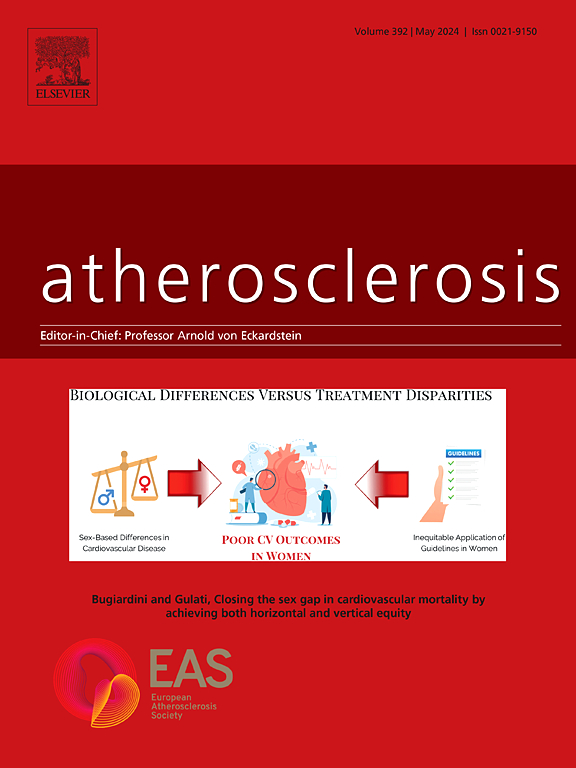Long-term trends in cardiovascular risk factors and cardiovascular risk following bariatric surgery: A 10-year prospective cohort study
IF 5.7
2区 医学
Q1 CARDIAC & CARDIOVASCULAR SYSTEMS
引用次数: 0
Abstract
Background and aims
Bariatric surgery (BS) leads to a durable weight loss and remission of diabetes, but the long-term impact on hypertension and lipid disorders is not unequivocal. The aim of the study was to assess the impact of BS on the level of cardiovascular (CV) risk factors and estimate CV risk 10 years following BS.
Methods
The study included patients who underwent BS in 2010–2015, re-evaluated in 2023–2024. The CV risk was estimated using the Pooled Cohort Equations calculator.
Results
The analysis included 188 patients (76 % women), with a mean age of 43.3 ± 9.8 years, who underwent sleeve gastrectomy (73.4 %) and gastric bypass (26.6 %). The observation period lasted 10 (9–11) years, and BMI decreased from 41.7 (38.2–46.0) kg/m2 to 33.9 (29.4–38.8) kg/m2 (p < 0.001). The prevalence of hypertension decreased from 76.6 % to 67.0 % (p < 0.05), while the prevalence of diabetes (31.9 % vs. 23.9 %; p = 0.08), hypercholesterolemia (77.1 % vs. 70.7 %; p = 0.16), and smoking (from 35.6 % to 31.4 %; p = 0.39) did not change significantly. CV risk increased from 1.6 % (0.6–4.2 %) to 2.6 % (1.0–6.7 %) (p < 0.001). Since patients examined during the follow-up examination were 10 years older and since age is a main driver of CV risk, we also calculated CV risk using the baseline age, which was significantly lower, 1.1 % (0.4–3.0 %; p < 0.001 vs baseline).
Conclusions
Long-term weight reduction following BS is related to the decrease in the estimated CV risk.

减肥手术后心血管危险因素和心血管风险的长期趋势:一项10年前瞻性队列研究
背景和目的减肥手术(BS)可导致持久的体重减轻和糖尿病缓解,但对高血压和脂质紊乱的长期影响尚不明确。该研究的目的是评估BS对心血管(CV)危险因素水平的影响,并估计BS后10年的CV风险。方法该研究纳入了2010-2015年接受BS治疗的患者,并于2023-2024年重新评估。使用Pooled Cohort equation计算器估计CV风险。结果188例患者(76%为女性),平均年龄43.3±9.8岁,分别行袖式胃切除术(73.4%)和胃分流术(26.6%)。观察10(9-11)年,BMI由41.7 (38.2-46.0)kg/m2降至33.9 (29.4-38.8)kg/m2 (p <;0.001)。高血压患病率由76.6%降至67.0% (p <;0.05),而糖尿病患病率(31.9% vs. 23.9%;P = 0.08),高胆固醇血症(77.1% vs. 70.7%;P = 0.16),吸烟(从35.6%增至31.4%;P = 0.39)无显著变化。CV风险增加1.6%(0.6 -4.2%)到2.6% (1.0 -6.7%)(p & lt;0.001)。由于随访检查期间检查的患者年龄大于10岁,并且年龄是CV风险的主要驱动因素,因此我们还使用基线年龄计算CV风险,该基线年龄明显较低,为1.1% (0.4 - 3.0%;p & lt;0.001 vs基线)。结论:BS术后长期减重与CV风险降低有关。
本文章由计算机程序翻译,如有差异,请以英文原文为准。
求助全文
约1分钟内获得全文
求助全文
来源期刊

Atherosclerosis
医学-外周血管病
CiteScore
9.80
自引率
3.80%
发文量
1269
审稿时长
36 days
期刊介绍:
Atherosclerosis has an open access mirror journal Atherosclerosis: X, sharing the same aims and scope, editorial team, submission system and rigorous peer review.
Atherosclerosis brings together, from all sources, papers concerned with investigation on atherosclerosis, its risk factors and clinical manifestations. Atherosclerosis covers basic and translational, clinical and population research approaches to arterial and vascular biology and disease, as well as their risk factors including: disturbances of lipid and lipoprotein metabolism, diabetes and hypertension, thrombosis, and inflammation. The Editors are interested in original or review papers dealing with the pathogenesis, environmental, genetic and epigenetic basis, diagnosis or treatment of atherosclerosis and related diseases as well as their risk factors.
 求助内容:
求助内容: 应助结果提醒方式:
应助结果提醒方式:


